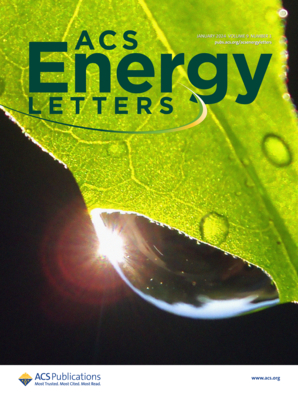Engineering Ligand-Functionalized Layers for Enhanced Fe2+ Capture and Stable Deposition in All-Iron Flow Batteries
IF 18.2
1区 材料科学
Q1 CHEMISTRY, PHYSICAL
引用次数: 0
Abstract
All-iron aqueous redox flow battery (ARFB) is a promising candidate for next-generation large-scale energy storage, due to low cost and environmental benignity, but the low reversibility of the Fe anode limits its long-term cycling stability. Herein, a 3-mercaptopropionic acid (MPA) ligand-functionalized layer (LFL) is utilized to achieve a highly reversible Fe-MPA anode. The MPA LFL not only minimizes corrosion and hydrogen evolution in acidic electrolyte, but also actively captures Fe2+ ions and controls interfacial deposition. Specifically, the MPA LFL homogenizes Fe2+ ion flux at the electrode interface, acting as a regulator that suppresses the dendritic iron growth and facilitates the reversible anode plating/stripping. Consequently, the all-iron ARFB based on the Fe-MPA anode delivers high Coulombic efficiency of ∼99.5% and energy efficiency of ∼75% over 330 h at 20 mA cm–2. This study highlights the strategy of designing function-oriented ligand-electrode interface for improving the stability of ARFBs.

全铁液流电池中增强Fe2+捕获和稳定沉积的工程配体功能化层
全铁水氧化还原液流电池(ARFB)由于其低成本和环境友好性,是下一代大规模储能的有希望的候选者,但铁阳极的低可逆性限制了其长期循环稳定性。本文利用3-巯基丙酸(MPA)配体功能化层(LFL)实现了高可逆的Fe-MPA阳极。MPA LFL不仅可以最大限度地减少酸性电解液中的腐蚀和析氢,还可以积极捕获Fe2+离子并控制界面沉积。具体来说,MPA LFL在电极界面处均匀化Fe2+离子通量,起到抑制枝晶铁生长和促进可逆阳极镀/剥离的调节作用。因此,基于Fe-MPA阳极的全铁ARFB在20 mA cm-2下,在330小时内具有高达99.5%的高库仑效率和高达75%的能量效率。本研究强调了设计功能取向配体-电极界面以提高arfb稳定性的策略。
本文章由计算机程序翻译,如有差异,请以英文原文为准。
求助全文
约1分钟内获得全文
求助全文
来源期刊

ACS Energy Letters
Energy-Renewable Energy, Sustainability and the Environment
CiteScore
31.20
自引率
5.00%
发文量
469
审稿时长
1 months
期刊介绍:
ACS Energy Letters is a monthly journal that publishes papers reporting new scientific advances in energy research. The journal focuses on topics that are of interest to scientists working in the fundamental and applied sciences. Rapid publication is a central criterion for acceptance, and the journal is known for its quick publication times, with an average of 4-6 weeks from submission to web publication in As Soon As Publishable format.
ACS Energy Letters is ranked as the number one journal in the Web of Science Electrochemistry category. It also ranks within the top 10 journals for Physical Chemistry, Energy & Fuels, and Nanoscience & Nanotechnology.
The journal offers several types of articles, including Letters, Energy Express, Perspectives, Reviews, Editorials, Viewpoints and Energy Focus. Additionally, authors have the option to submit videos that summarize or support the information presented in a Perspective or Review article, which can be highlighted on the journal's website. ACS Energy Letters is abstracted and indexed in Chemical Abstracts Service/SciFinder, EBSCO-summon, PubMed, Web of Science, Scopus and Portico.
 求助内容:
求助内容: 应助结果提醒方式:
应助结果提醒方式:


